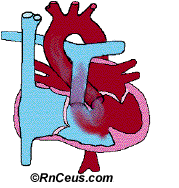learn more about
Ventricular Septal Defect: Effects, Assessment & Treatment


At the end of this course, participants
will able to:
* Describe the anatomy of the normal heart with respect to blood flow to and
from the lungs.
* Compare cyanotic heart defects with acyanotic heart defects.
* Specify prevalence of ventricular septal defect (VSD) in the population.
* Compare and contrast the flow of blood in the normal heart with blood flow
in the heart affected by VSD.
* Describe early effects of large VSDs; include reasons why children with
VSD are prone to congestive heart failure (CHF).
* Distinguish later effects of large VSDs.
* Explain why VSDs in newborns are often not evident.
* List diagnostic tools used to assess VSD.
* List symptoms of congestive heart failure (CHF) in children.
* List 2 common medications for CHF management and discuss actions of each
medication, pediatric dosages and precautions.
* Describe a palliative therapy for VSD.
* Describe definitive therapy for VSD including risks and benefits.